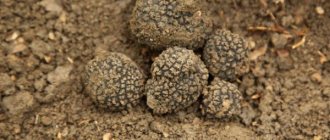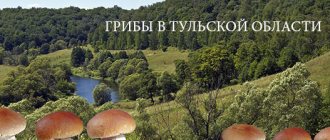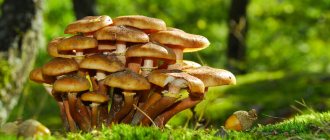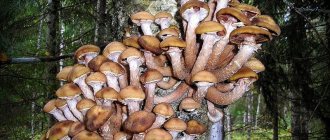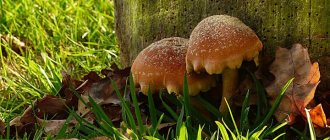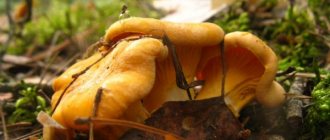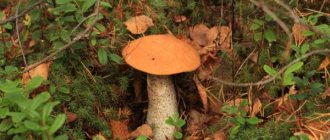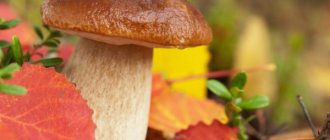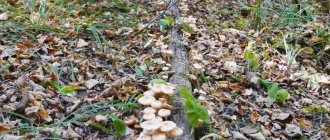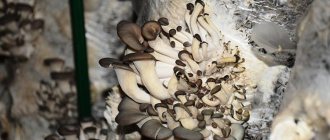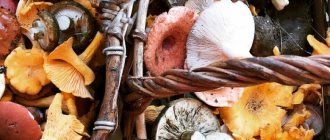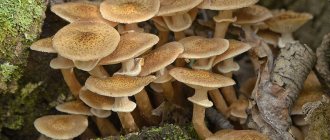Mushroom places in the Voronezh region 2022 are of interest to lovers of “quiet hunting”. Located in the south-eastern part of Russia, this area has ideal climatic conditions for the germination of mushroom species. Summers here are hot and winters are moderately cold. An impressive number of forests, a lot of reservoirs, and swampy areas, where you can also find a worthy “trophy,” also play a big role.
When compiling a general map of mushrooms in the Voronezh region, it is important not to miss the main forest plantations, meadows and forest belts of this territory. Keep in mind that when choosing an area, you need to count on certain types of mushrooms. Some are found in marshy soils, while others are found in pine or deciduous forests on sandy soils. In order not to waste time, find out in advance about all the features of a particular soil. This will allow you to know what type of mushrooms you can expect when you go mushroom picking.
What types of edible honey mushrooms grow in Voronezh and the region
The weather conditions and ecological system of the Voronezh region fully meet the biological needs of honey mushrooms. The spread of forests, protected areas, the mixture of tree species - all these factors are favorable for the growth of mushrooms from early spring to winter.
In the Voronezh region there are more than 200 species of mushrooms with high nutritional value and conditionally edible. Honey mushrooms are distinguished by the time of fruiting and the place of growth.
Spring - grow in deciduous areas near oaks, aspens, and less often pine trees. They appear in May, after above-zero temperatures have set in. A popular species among mushroom pickers is the wood-loving collibia. Honey fungus with light flesh and a light brown cap has a pale spot in the center.
The most popular and widespread are summer ones. The color of the mushroom is brownish or dark yellow. They grow on birch remains or stumps.
Fruit bodies without a distinct odor with a pleasant taste. Appear in July, after heavy rains. The harvest season is short, the fruit body reaches biological ripeness in 3 days.
Autumn honey mushrooms (pictured) have been collected in Voronezh since late summer.
They grow on all types of wood in large groups. Externally, the fruit body is small in size and light brown in color. The cone-shaped cap is densely covered with small scales.
Winter honey mushrooms (pictured below) in the Voronezh region are collected from October to spring.
A variety with a pleasant fruity aroma and pronounced mushroom taste. A rounded cap with a mucous surface of a dark orange color. This is the only mushroom that bears fruit in winter, so it has no false doubles.
Meadows are the largest representatives of the species; they grow in groups, forming a semicircle or long rows.
Fruiting lasts for a long time - from spring to autumn. They are found in clearings, meadows, pastures, and on roadsides. Fruiting is abundant only in open areas and moist, fertile soil.
Read also
u0412u044b , u0432u0438u0434u043du043e, u0438u0437 u043fu043eu043au043eu043bu0435u043du0438u044f, u043au043eu0442u043eu0440u043eu043cu0443 u0 432u0434u043eu043bu0431u0438u043bu0438 u0432 u0433u043eu043bu043eu0432u0443 «u0435u0434u0430 u0431u044bu0432u0430u0435u0442 u0442u043eu043 bu044cu043au043e u0432 u0441u0443u043fu0435u0440u043cu0430u0440u043au0435u0442u0430u0445.” ","comment_image":false,"otvet_comment_id":"6402249″,"comment_username":"u0413u043eu0441u0442u044c","user_rank":"","count_likes":"","has_like":false>,
u00a0u041eu0442u0440u0430u0432u0438u043bu0441u044f u0431u043bu0435u0434u043du043eu0439 u043fu043eu0433u0430u043du043au043eu0439, u0438 u04 3eu043du0430 u0443u0431u0438u043bu0430 u0435u0433u043e u043fu0435u0447u0435u043du044c. u041eu043du0430 u043fu0440u0435u0432u0440u0430u0442u0438u043bu0430u0441u044c u0432 u0436u0435u043bu0435
Sources:
https://fermoved.ru/gribyi/v-voronezhskoj-oblasti.html https://gribysobiraem.info/gribnye-mesta-v-voronezhskoj-oblasti-2019/ https://moe-online.ru/news/ecology /1017570
Where honey mushrooms grow in the Voronezh region
The main concentration of the species is observed in oak groves and mixed forests. Large areas of forested areas in the Voronezh region are used in the woodworking industry. After the commercial timber is removed, dead wood, stumps and illiquid remains remain. This is an ideal place for the growth of honey mushrooms of any season, except meadow ones. The latter can be found just outside the city, near small ponds and rivers, in meadows among short grass.
Where are honey mushrooms collected near Voronezh?
In the suburban areas of Voronezh, you can collect honey mushrooms in several directions, a general overview of areas and settlements popular with mushroom pickers:
- Semiluksky district, the closest to the city. There is a pine forest and partially mixed tree species here. The main direction is to the villages of Orlov Log, Fedorovka and Malaya Pokrovka.
- One of the largest mushroom places is forests and clearings near Somovo station. To collect meadow mushrooms, choose the northern direction from the station, for other varieties - the eastern direction.
- Near the settlements of Sinitsino, Shuberskoye, Orlovo, Dubovka.
- Nizhnedevitsky district, Andreevka village at Kastornoye station.
- Ramonsky district is the main distribution of meadow representatives near the villages of Yamnoye and Medovka.
- For forest specimens they go to the forests of Novaya Usman.
You can also harvest a good harvest in the Voronezh region in the area of the Leather Cordon and Lake Maklyuk.
Forest areas where honey mushrooms grow in Voronezh and the Voronezh region
The main gathering places where autumn and winter honey mushrooms grow en masse in Voronezh:
- Usmansky pine forest;
- Tellerman Grove;
- Shipov forest;
- Chalk forest;
- Long Forest;
- Khrenovsky pine forest.
On the territory of the Voronezh region there are several nature reserves where the collection of honey mushrooms is allowed in unlimited quantities and forestry enterprises that are famous for the productivity of the species.
Forestries and reserves of the Voronezh region, where you can collect honey mushrooms
The main distribution area of honey mushrooms is in the Voronezh region:
- Khopersky Reserve. Located in the east of the region on the Khoper River, the forest consists of mixed species of trees and shrubs.
- Shipova oak grove, on the Osered River, Voronezh region.
- The Kamennaya Steppe nature reserve is located in the watershed of the Chigly, Elani, and Bityuga rivers.
- Somovskoe forestry is a protected area, so travel by personal transport is prohibited.
- Novousmanskoye forestry is located in the Khokholsky district.
- Semilukskoye forestry, a large accumulation of honey mushrooms in the Ramonsky district.
A popular place among mushroom pickers for collecting honey mushrooms in the Voronezh region is the Left Bank forestry area, located on the territory of the Leather cordon.
Do honey mushrooms grow in the Grafsky Nature Reserve?
The Grafsky Reserve is located in the south of the Voronezh Biosphere Reserve. The state-protected area is rich in numerous species of mushrooms. The land is well-groomed, there is no accumulation of dead wood and stumps. Honey mushrooms grow near the village of Krasnolesny, not far from the Grafskaya railway station.
Mushroom picking place, where is the best place to go hunting?
Before you go mushroom hunting, you should carefully study the map of the area and find out where the territory is removed from factories, cemeteries, garbage dumps and highways. The less polluted the soil, the higher the chance of harvesting a good and healthy harvest, free of toxins.
When honey mushrooms grow in Voronezh
The honey mushroom harvest continues throughout the year, with each species bearing fruit at a certain time. Spring is replaced by summer, then autumn and winter. The taste qualities of all representatives of the genus, except for wood-loving collibia, are not particularly different and the processing methods are also the same.
When can you collect spring honey mushrooms in the Voronezh region?
Spring honey fungus is not particularly in demand among mushroom pickers; many mistakenly classify it as an inedible species. Collibia is quite suitable for consumption; it grows on moss or leaf cushions in oak forests. Appears from late April or early May, depending on weather conditions. The first fruiting bodies can be found at a temperature of +7 0C, after heavy rains.
When does the collection of summer honey mushrooms begin in Voronezh and the region?
The summer species is the most fertile. In a small area, you can harvest up to three buckets of crops in a short time. The mushroom settles mainly near aspen or birch trees. In warm weather, the first families can be found in June; the main fruiting occurs in July and continues until the first frost.
When can you collect autumn honey mushrooms in the Voronezh region in 2022?
The autumn representative does not bear fruit abundantly every year; this depends on the climatic conditions of the region and the biological characteristics of the species. If in 2022 the collection of honey mushrooms was not massive, then 2022 will bring a bountiful harvest. Mushroom picking begins at the end of the last month of summer, when the temperature drops and seasonal rains begin. Autumn honey mushrooms are collected in Voronezh before the first frost.
Winter mushroom collection season in Voronezh in 2022
Winter specimens appear at the moment when the mushroom season is completely over. Mushrooms grow quite high from the ground on the trunks of old trees. The first harvest is harvested in November. The biological cycle continues until the air temperature drops to -100C. Fruit bodies are 80% water; when frozen, their growth stops, but their nutritional value is completely preserved. At the first thaw, in the Voronezh region this is around the end of February, they begin to grow again.
Orders from restaurants
I myself found two regular customers in everyday life, they are representatives of restaurants. First, I searched through Yandex to see which cafes and restaurants serve mushroom dishes, compiled a list and selected small establishments. I found their phone numbers on the website, called and asked the chef to answer the phone. The conversation goes something like this:
Me: Good afternoon, I sell mushrooms, from five kilograms. Can I speak to Chef Alexander?
CHEF: This is Alexander, I’m listening to you.
Me: Hello, Alexander! I collect wild mushrooms and bring them to the city. The season is coming soon. If you want, we can collaborate.
SH: Hmm, interesting.
I'm fine. What mushrooms do you usually take? What volume? What are the processing requirements?
If the mushrooms and supply volume were suitable, we agreed on an order. So I called about twenty restaurants, two agreed, and now I bring them mushrooms every season.
I didn’t work closely with restaurants because I wouldn’t be able to collect a large order. I didn’t call large networks at all. It seemed to me that they had such a volume that I could not get them.
Competitors
There are two types of sellers: professional resellers and individual collectors like me.
Professional resellers purchase mushrooms in remote villages and bring mushrooms to the city. They travel to buy mushrooms as far as possible to save money. Residents of remote villages sell mushrooms at least four times cheaper than in the city. For example, last year chanterelles in the Pskov region were sold for 50 rubles per kilogram, and in St. Petersburg - for 300.
These sellers then sort the mushrooms and transport them to markets and tents. The duration of the trips is two to three days, and most mushrooms live only 12 hours. Many resellers bring only chanterelles, which are stored for a long time, and the rest of the mushrooms are processed, for example into pickles or frozen.
Individual pickers sell mushrooms near the metro, in markets and on highways. There are two problems with them: small volume and the issue of safety and hygiene. Usually pickers sell mushrooms in piles of 5-7 pieces, because buyers take a little at a time. A client walks by, sees mushrooms and buys spontaneously, according to his mood. Street vendors do not stand all the time, but only when there is production. Let’s imagine: a housewife needed three buckets for supplies, but there was no one at the metro station—no one to buy from.
The quality of mushrooms and the place of collection from such sellers also raises questions. On the highway, mushrooms lie on folding tables, cars drive past, dust settles. At the metro, goods are laid out on boxes or directly on the ground, instead of a tablecloth there is a newspaper or a bag. The seller could be a gloomy man in an old tracksuit, a tipsy group, or a sweet old lady.
Several times I saw a man crawling out of a roadside ditch towards a seller on the highway, dragging a filled basket behind him. He put the mushrooms on the table and disappeared into the forest again. It is unlikely that this person went the required two kilometers from the road. Mushrooms also grow along the roadsides, but eating them is dangerous.
Mushrooms absorb harmful substances from the soil, so it is important to collect them at a distance of no closer than two kilometers from highways and factories
A neat mushroom picker with clean hands and mushrooms, selling on the highway or near the metro, is a rarity. If you dress neatly and keep an eye on mushrooms, you will always have a buyer.
Be careful, poisonous mushrooms in the Voronezh area!
In addition to mushrooms of the Voronezh region with beneficial qualities, there are a number of poisonous mushrooms. This “collection” is no less rich and consists of the following species.
The waxy govorushka can be easily mistaken for an edible option. Its elegant appearance is not at all embarrassing: a whitish elegant cap with a characteristic shine, a rather thick and elastic leg, and the inability to secrete milky juice - these are the main characteristics. It can appear in the forest in summer or autumn. Its cunning lies in the fact that it is many times more poisonous than the fly agaric.
No less insidious is the sulfur-yellow false honey fungus, similar to the honey fungus growing on mossy stumps. The mushroom is predominantly yellow on top, but has a slightly reddish tint in the middle. He “pleases” with his appearance in September.
It is also easy to confuse with the honey fungus the plush spider web: the same brown cap. But what gives it away is its thick stem of a dirty yellow hue, slightly reminiscent of radish in smell.
Svinushka thin grows in coniferous and mixed forests. For a long time it was considered a conditionally edible plant, but recent research by mycologists has shown that the mushroom is capable of accumulating heavy metals, loves car exhaust fumes, and releases all this to humans when cooked. Her leg is dense, her hat resembles a funnel, and is decorated with terry at the edges.
